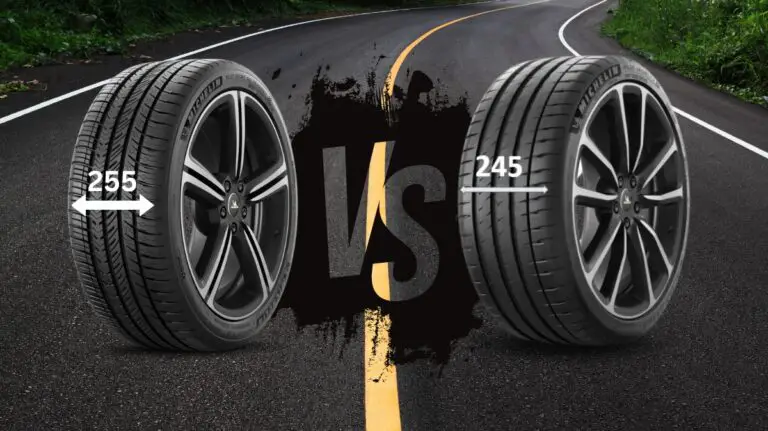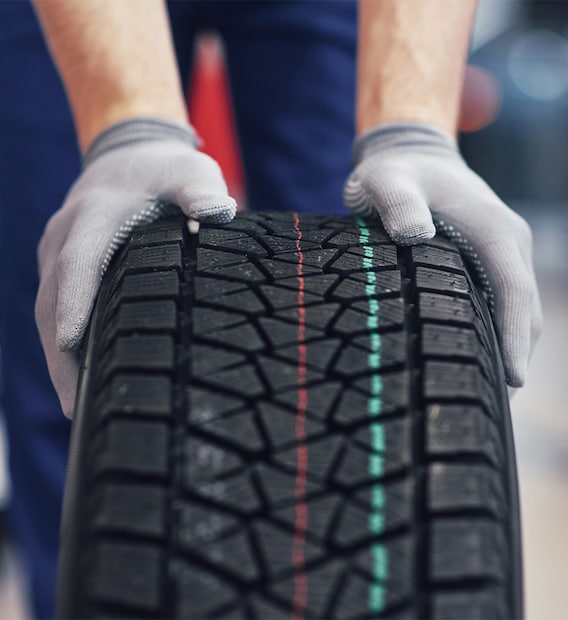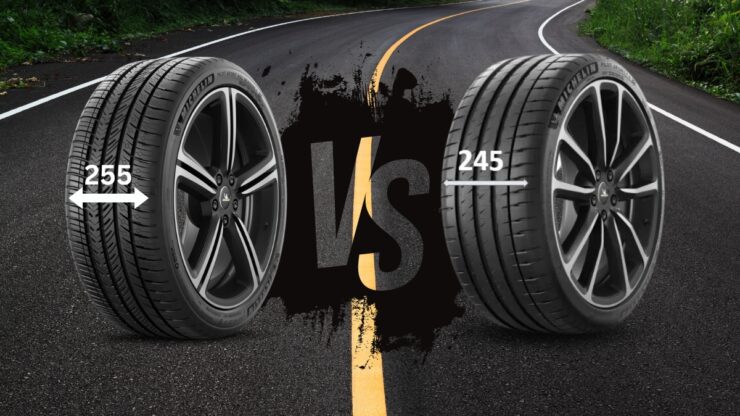When it comes to the difference between 225 and 235 tires, the main distinction lies in the width of the tires. 225 tires have a width of 225 millimeters, while 235 tires have a width of 235 millimeters.
The difference in width can impact the handling, traction, and overall performance of the vehicle. Additionally, it can also affect fuel efficiency and comfort level while driving. Understanding the difference between these two tire sizes is important for making an informed decision when choosing the right tires for your vehicle.
We will explore the key differences between 225 and 235 tires and how each size can impact your driving experience.


Credit: www.westbroadkia.com
Differences In Size
When considering the differences between 225 and 235 tires, one of the key aspects to understand is the variation in size. The size of a tire plays a crucial role in defining its performance, handling, and stability.
225 and 235 represent the width of the tires in millimeters. The main difference lies in the width, where 225 tires are narrower than 235 tires, resulting in variations in the contact patch with the road surface.
225 Tires: Due to their narrower width, 225 tires provide a slightly sharper and more responsive handling. They are ideal for precise steering and agility, making them suitable for performance-oriented driving.
235 Tires: With their wider profile, 235 tires offer improved stability and better grip, especially during high-speed maneuvers and cornering. This width provides a larger contact patch, enhancing traction and overall stability.

Credit: en.wikipedia.org
Tread Patterns And Design
The tread patterns and design of 225 and 235 tires play a crucial role in their performance, handling, and traction on the road. Understanding the differences in tread design can help you make an informed decision when choosing between these two tire sizes.
Comparison Of Tread Designs
When comparing the tread designs of 225 and 235 tires, it’s important to consider the width, depth, and pattern of the treads. Wider tires often have more complex tread patterns to maximize grip and improve performance in various driving conditions. On the other hand, narrower tires may have simpler tread designs that are more suited for specific road conditions. The tread design can affect the tire’s ability to channel water away from the contact patch, providing better traction and improved handling.
Traction And Grip Performance
The tread design also plays a significant role in the traction and grip performance of 225 and 235 tires. The tread patterns are designed to provide optimal surface contact and enhance grip on the road. Deeper grooves and sipes in the tread design can improve traction on wet and slippery surfaces, while solid rib patterns may offer better stability and handling during dry conditions. It’s essential to consider the specific driving conditions and terrain where the tires will be used to ensure optimal traction and grip performance.
Speed And Load Indexes
–When it comes to 225 vs 235 tires, understanding the Speed and Load Indexes is crucial for your driving experience.
Understanding Speed And Load Ratings
–Speed index indicates the maximum speed a tire can sustain safely, represented by a letter code.
–Load index signifies the maximum weight a tire can support, denoted by a numerical value.
Effects On Driving Experience
–Proper speed and load ratings ensure safe handling and performance of your vehicle on the road.
–Incorrect ratings may lead to compromised control, stability, and overall driving experience.
–Ensure your tires’ ratings align with your vehicle’s requirements for a smooth, safe drive.
Fuel Efficiency And Mileage
When considering the difference between 225 and 235 tires, the impact on fuel efficiency and mileage is an important factor to account for. The wider the tire, the more rolling resistance it creates, potentially resulting in decreased fuel efficiency and mileage.
It’s essential to choose the right tire size to optimize performance.
Fuel efficiency and mileage are crucial factors to consider when it comes to choosing the right tires for your vehicle. The width of the tires plays a significant role in determining fuel consumption. In this section, we will explore the impact of tire width on fuel efficiency and mileage, specifically comparing the differences between 225 and 235 tires.Role Of Tire Width In Fuel Consumption
The width of the tire, expressed in millimeters, affects the rolling resistance and aerodynamics of the vehicle. A narrower tire, such as the 225, typically has less rolling resistance, which means the engine doesn’t have to work as hard to move the vehicle forward. As a result, narrower tires tend to offer better fuel efficiency. This is particularly beneficial for city driving and commuting, where frequent stops and starts can significantly impact fuel consumption. On the other hand, wider tires, like the 235, can enhance handling and provide better traction, especially in wet or snowy conditions. However, wider tires generally create more rolling resistance, leading to decreased fuel efficiency. If you mainly drive on highways or enjoy a more aggressive driving style, wider tires may be a suitable choice for you.Longevity Of 225 Vs 235 Tires
Apart from fuel efficiency, another essential consideration is the longevity of the tires. The width of the tire also plays a role in determining its lifespan. Wider tires, such as the 235, tend to have a larger contact patch with the road surface. This greater contact area can result in improved stability and increased traction, but it can also lead to faster wear. With wider tires, you might need to replace them more frequently, reducing their overall lifespan. On the other hand, narrower tires like the 225 provide less contact area, which can result in reduced traction on certain road surfaces. However, narrower tires generally have a longer lifespan due to less wear and tear. When it comes to choosing between 225 and 235 tires, it’s crucial to consider your driving habits, road conditions, and priorities. If fuel efficiency and longevity are your top concerns, the narrower 225 tires may be the optimal choice. However, if you prioritize enhanced handling and traction, the wider 235 tires may be more suitable for your needs. In conclusion, the width of the tires significantly impacts fuel efficiency and longevity. While narrower 225 tires generally offer better fuel efficiency and longevity, wider 235 tires provide better traction and handling. Consider your driving style and priorities to make an informed decision between the two options.Compatibility And Installation
When it comes to tires, choosing the right size for your vehicle can make a significant difference in performance and safety. One common debate is between the 225 and 235 tire sizes. While they may seem similar, there are some important distinctions to consider.
Suitability For Different Vehicles
Before diving into the details, it’s essential to understand the suitability of 225 and 235 tires for different vehicles. While both sizes can fit various vehicles, it’s crucial to check your car’s manual or consult a professional to ensure compatibility. Generally, 225 tires are suitable for smaller cars and compact sedans, while 235 tires are better suited for larger vehicles like SUVs and trucks.
Professional Advice On Installation
The installation process is an important aspect when it comes to tire performance and longevity. Installing tires correctly not only ensures your safety but also maximizes their lifespan. Here are some professional tips and advice on tire installation:
- Inspect your tires before installation: Before beginning the installation process, thoroughly inspect your new tires for any visible damage or defects. This simple step can help prevent any issues later on.
- Familiarize yourself with the vehicle’s manual: Each vehicle has specific guidelines for tire installation. Consult your vehicle’s manual or reach out to a professional for instructions on mounting and balancing your tires correctly.
- Seek professional help if unsure: If you’re uncertain about the installation process, it’s always better to seek professional help. A skilled technician can ensure that your tires are installed correctly, minimizing the risk of accidents or problems down the road.
- Consider using a torque wrench: When tightening the lug nuts, using a torque wrench can help you avoid overtightening or undertightening. This ensures a proper and secure fit for your tires.
By following these professional tips and seeking expert advice if needed, you can ensure the smooth and efficient installation of your tires. This not only enhances your driving experience but also promotes your safety on the road.

Credit: www.thompsontoyota.com
Cost Analysis
When comparing 225 and 235 tires, one crucial aspect to consider is the cost difference between the two options. Let’s delve into the cost analysis to help you make an informed decision based on your budgetary requirements.
Price Comparison Between 225 And 235 Tires
- Opting for 225 tires typically results in a lower upfront cost.
- These tires are popular for their affordability and widespread availability.
- Initial savings with 225 tires can be a key factor for budget-conscious consumers.
- 235 tires may have a slightly higher price point compared to 225 tires.
- These tires often offer enhanced performance features which can justify the higher cost.
- Investing in 235 tires could be beneficial for those prioritizing performance over initial cost savings.
Value For Money Considerations
- Consider your driving needs and priorities when deciding between 225 and 235 tires.
- Evaluate the longevity and performance benefits that come with higher-priced 235 tires.
- Consult with a tire expert to determine the best value for money based on your specific requirements.
Frequently Asked Questions Of 225 Vs 235 Tires Difference
What Is The Difference Between 225 And 235 Tires?
The main difference between 225 and 235 tires is the width. A 225 tire is narrower than a 235 tire. This width difference can affect handling, traction, and fuel efficiency. It’s important to choose the right tire size for your vehicle and driving conditions.
Which Tire Size Should I Choose: 225 Or 235?
The choice of tire size depends on various factors such as your vehicle’s specifications, driving style, and road conditions. Generally, a wider tire (235) offers better stability and cornering grip, while a narrower tire (225) may provide better fuel efficiency and snow traction.
Consult your vehicle’s manual or tire professional for recommended tire sizes.
How Does Tire Width Affect Fuel Efficiency?
Tire width can affect fuel efficiency due to differences in rolling resistance. Narrower tires (such as 225) generally have lower rolling resistance, which means the engine doesn’t have to work as hard to move the vehicle. This can result in improved fuel efficiency.
However, the difference may be minimal, and other factors like tire pressure and driving habits also play a role.
Can I Use 225 Tires Instead Of 235?
In most cases, you can use 225 tires instead of 235 tires, as long as they are compatible with your vehicle’s rim size and load rating. However, it’s important to consider the potential impact on handling, traction, and vehicle performance.
Consult your vehicle manufacturer or a tire professional for specific recommendations.
Conclusion
After analyzing the 225 vs 235 tires difference, it’s clear that choosing the right size impacts performance. Understanding the pros and cons of each can enhance your driving experience. Ultimately, your decision should align with your driving habits and vehicle’s specifications for optimal results.
Make an informed choice for a smoother ride.